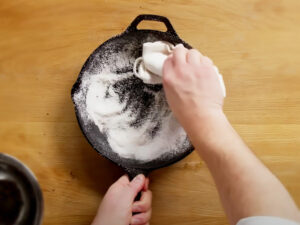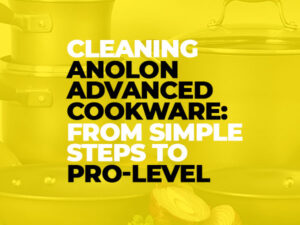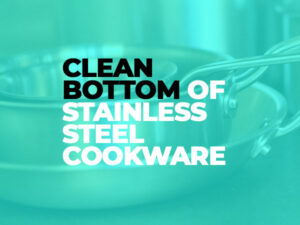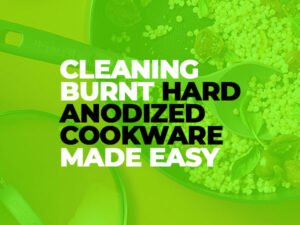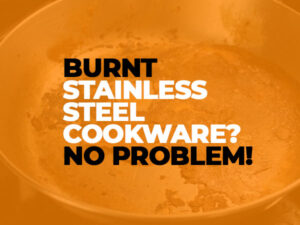As an avid collector and enthusiast of vintage aluminum cookware, I understand its charm and beauty. From sleek mid-century designs to its durability and heat conductivity properties, vintage aluminum cookware is truly an admirable collectible that should be treasured. Care and maintenance for vintage aluminum cookware are of equal importance in order to extend its useful life and ensure it continues to shine with age.
I will share my expertise and insights in this step-by-step guide on how best to clean and care for vintage aluminum cookware. As an experienced collector or vintage kitchenware enthusiast, this guide offers valuable advice and techniques for maintaining the beauty and functionality of vintage aluminum cookware. So let’s put on our protective gloves and dive headfirst into caring for vintage aluminum cookware!
What Is Vintage Aluminum Cookware, and Why is it Different?
Vintage aluminum cookware refers to kitchen vessels and cookware made of aluminum that was manufactured before 1960, usually between the mid-20th century to earlier decades. Usually, these pieces feature unique designs, finishes, and craftsmanship which distinguishes them from modern aluminum cookware pieces.
Vintage aluminum cookware stands out for its nostalgic appeal and historical significance, drawing collectors and enthusiasts alike with its retro aesthetics, sleek lines, and iconic shapes that bring charm and nostalgia into any kitchen. Furthermore, collectors prize its excellent heat conductivity that allows even and efficient cooking as well as being passed down from generation to generation – often becoming treasured heirlooms in families across time.
Vintage aluminum cookware may require special care due to its age and unique features, and proper care and cleaning should be given accordingly in order to preserve its beauty, functionality, and value for years. We will cover step-by-step methods and tips on how to maintain vintage aluminum cookware so it continues to remain part of your kitchen’s repertoire for many more years to come.
Why Does Cleaning Vintage Aluminum Cookware Differ From Cleaning Modern Cookware?
Cleaning vintage aluminum cookware differs significantly from modern cookware for several reasons. Vintage pieces may feature unique finishes like anodized or brushed finishes that require specific methods of care when maintaining their aesthetic appearance, whereas modern cookware typically features non-stick coatings or stainless steel finishes with unique cleaning requirements that may vary significantly from vintage items.
Second, vintage aluminum cookware may be more prone to staining, discoloration and oxidation due to age and usage over the years. Although the patina adds charm and character, special care may be necessary in removing stains or discolorations without harming its surface.
Vintage aluminum cookware may not be dishwasher-safe due to older pieces with handles or knobs made of materials that do not thrive under high temperatures, so hand washing may be the preferred way to maintain its condition; modern cookware typically designed for dishwasher use may need special treatment in this regard.
Considering these factors, it is crucial to comprehend the unique properties of vintage aluminum cookware and to employ appropriate cleaning techniques in order to preserve and ensure its long-term viability.
Also Read: The Bottom Line on Cleaning Stainless Steel Cookware: A Comprehensive Guide to Gleaming Results
What Tools and Materials Do I Need for Cleaning Vintage Aluminum Cookware?
Cleaning vintage aluminum cookware requires several essential materials and tools in order to be done effectively and safely, such as:
- Choose mild dish soap: When selecting an aluminum cookware piece from vintage collections, it is essential that it does not contain harsh chemicals or abrasives as these may damage its surface and compromise its integrity. When selecting an aluminum cooking set with this requirement in place, choose an aluminum dish soap without these contaminants that are specifically tailored to its use on it.
- Soft Cloths or Sponges: Instead of using harsh materials such as steel wool to scrub away aluminum surfaces, opt for gentle cloths or nonabrasive sponges as these will cause less scratching to its surface.
- Baking soda or cream of tartar: These natural abrasives can be used to safely remove stains or discolorations from vintage aluminum cookware. Simply combine with water for spot-cleaning purposes.
- White vinegar or lemon juice: Both acidic substances can effectively remove tarnish or oxidation from vintage aluminum cookware, especially when combined with water in a spray bottle for convenient application.
- A Toothbrush or soft bristle brush: For cleaning hard-to-reach areas or stubborn stains on vintage aluminum cookware.
- Soft towels or microfiber cloths: Soft towels or microfiber cloths are an ideal way to dry and polish vintage aluminum cookware after cleaning in order to prevent water spots or streaks from forming on it.
By having these materials and tools readily available, you’ll be prepared to properly clean and care for your vintage aluminum cookware to preserve its looks for many years to come.
How Can I Safely Clean Vintage Aluminum Cookware of Stains and Discoloration?
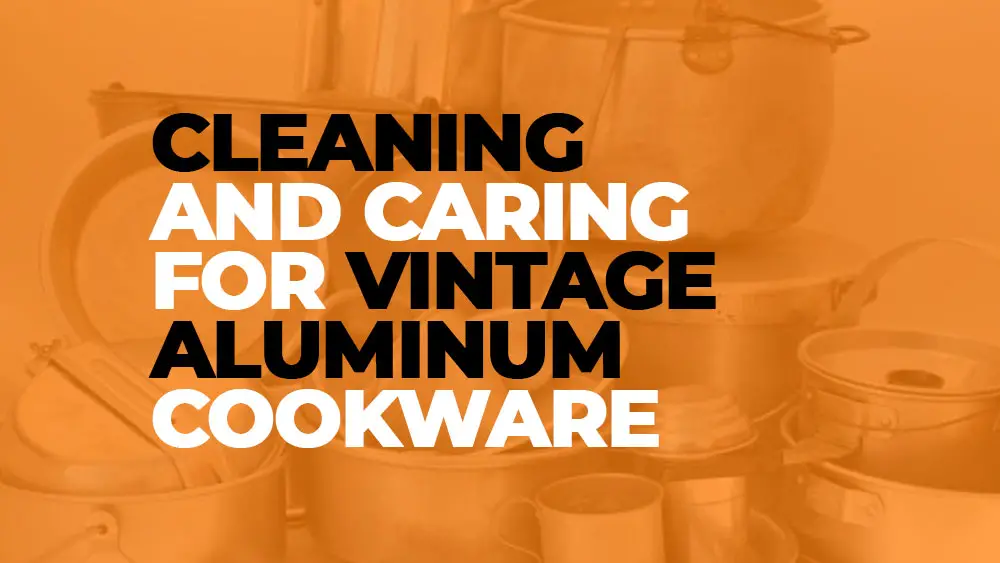
Vintage aluminum cookware may become stained and discolored over time due to various factors, including age, usage, heat exposure, and food. With proper care and cleaning procedures in place, however, stains and discolorations from vintage aluminum can be safely removed without harming its surface – here is a step-by-step guide on how you can quickly clean and restore its shine!
Step 1: Assemble Your Materials
To start, ensure you have all of the materials and tools required. These include mild dish soap, soft cloths or sponges, baking soda or cream of tartar, white vinegar or lemon juice, toothbrush or soft bristle brush as well as soft towels or microfiber cloths.
Step 2: Wash with Mild Dish Soap
Begin cleaning your vintage aluminum cookware using mild dish soap and warm water. Gently scrub with a soft cloth or sponge, paying special attention to areas with stains or discolorations. Avoid using harsh scouring pads or steel wool as these may scratch its surface; rinse well afterwards and allow the surface to air-dry on its own before rinsing with more water before storing on a soft towel for storage.
Step 3: Make a Paste With Baking Soda or Cream of Tartar
For stubborn stains or discolorations on vintage aluminum cookware, create a thick paste by mixing small amounts of baking soda or cream of tartar with water to form a thick paste that you apply directly over affected areas and allow to sit for several minutes before wiping clean with a damp rag.
Step 4: Gently Scrub With a Soft Bristled Brush
To gently scrub stained or discolored areas with paste, use a toothbrush or soft-bristled brush with soft bristles and apply small, even strokes of pressure with your brush bristles to apply the paste to those spots that require it. Make sure not to apply too much pressure, as too much scrubbing can scratch the aluminum’s surface and damage its finish. After you’ve thoroughly scoured each area, rinse with water and dry with a soft towel afterwards.
Step 5: Use White Vinegar or Lemon Juice
For stubborn stains or discolorations, white vinegar or lemon juice are acidic substances that may help remove tarnish or oxidation from aluminum cookware. Combine equal parts water and vinegar/lemon juice in a spray bottle, spray onto stained areas of vintage aluminum cookware and allow it to sit before gently scrubbing using a soft cloth/sponge and then rinsing/rinsing off with water and drying with soft towel after.
Step 6: Dry and Polish
Once finished cleaning your vintage aluminum cookware, it is crucial that it is dried thoroughly to avoid water spots or streaks from forming on its surfaces. Use soft towels or microfiber cloths to dry the pieces properly – pay special attention when drying handles, knobs, or hard-to-reach areas such as handles. Once your cookware is dry, polish its shine using another soft towel or microfiber cloth for the best results.
Tips for Cleaning Vintage Aluminum Cookware
Never use abrasive cleaners, harsh chemicals or steel wool on vintage aluminum cookware as this could damage its surface. When done cleaning up with soapy water or cleaning agents, make sure you rinse well after each session to get rid of residue left by these methods.
If your vintage aluminum cookware has stubborn stains or discolorations that cannot be eliminated using mild dish soap, baking soda, cream of tartar, white vinegar or lemon juice as remedies, consider consulting a professional cleaner who specializes in restoring vintage cookware.
Cleaning vintage aluminum cookware requires gentle care to remove stains and discolorations without damaging its surface. By following this step-by-step guide and using appropriate materials and tools, you can safely restore its shine with your beloved vintage aluminum cookware.
What Are the Best Methods for Cleaning Vintage Aluminum Cookware Without Damaging It?
Vintage aluminum cookware is highly prized for both its durability and heat conductivity properties, as well as its nostalgic charm. However, cleaning vintage aluminum requires special care so as to not cause damage to its surface. Here are some effective strategies for safely cleaning vintage aluminum cookware without doing any lasting harm to its surfaces.
Hand Washing with Mild Dish Soap
One of the safest and most efficient ways of cleaning vintage aluminum cookware is by hand washing it using mild dish soap in warm water. Avoid using harsh materials, like steel wool scouring pads, as these may scratch their surface. Instead, use a soft cloth or sponge scouring pads or soft sponge scouring pad to gently scrub your cookware’s surfaces focusing especially on any spots or discoloration areas before thoroughly rinsing with clean water and drying with a soft towel afterwards.
Baking Soda or Cream of Tartar Paste
For stubborn stains or discolorations on vintage aluminum cookware, creating a paste with baking soda or cream of tartar may help. Mix a small amount with water to form a thick paste. Apply this to affected areas using a toothbrush or soft-bristled brush before rinsing and drying with a soft towel afterwards.
White Vinegar or Lemon Juice
Another effective solution for cleaning vintage aluminum cookware is using white vinegar or lemon juice, both acidic substances that can help loosen tarnish or oxidation from its surface. Combine equal parts water and white vinegar or lemon juice in a spray bottle, spray onto stained or discolored areas, let sit a few minutes, then gently scrub away using a soft cloth or sponge, rinse out, and dry with soft toweling afterwards.
Aluminum Foil and Water
Aluminum foil is an effective way of cleaning vintage aluminum cookware without scratching its surface. Simply crumple up some aluminum foil into a ball and soak it in water; use this dampened foil to gently scrub stained or discolored areas on your cookware without causing damage; rinse out well afterwards, and dry with a soft towel afterwards.
Cream of Tartar and Lemon Juice Paste
For particularly stubborn stains or discoloration, creating a paste from cream of tartar and lemon juice may help. Mix equal parts cream of tartar and lemon juice until you achieve a thick paste that adheres to stained areas. Apply this paste directly over stained areas and allow it to set for several minutes before gently scrubbing with a soft cloth or sponge; rinse well afterwards and dry using soft toweling.
Bar Keepers Friend
Bar Keepers Friend is an effective cleaning product designed for vintage aluminum cookware, featuring mild abrasives that help remove stains and discolorations without scratching its surface. Simply wet the cookware before wetting it with water before applying Bar Keepers Friend with a soft cloth or sponge and gently scrubbing away at stained or discolored areas using Bar Keepers Friend before rinsing with water and drying with soft toweling afterwards.
Hot Water and Vinegar Soak
If your vintage aluminum cookware has stubborn stains or discolorations, try soaking it in a solution of hot water and white vinegar. Fill a sink or basin with hot water, adding 1 cup of white vinegar per gallon of water in order to drench your cookware with this solution, leaving it to soak for several hours or overnight before gently scrubbing with a soft cloth or sponge, rinse in water, then dry using a soft towel after use.
Avoid Harsh Chemicals and Abrasive
It is crucial to use mild cleaning solutions on vintage aluminum cookware, such as mild dish soap, baking soda, cream of tartar, white vinegar or lemon juice when cleaning it – anything too harsh could damage its surface and result in scratches or discoloration of its surface. Furthermore, oven cleaners with harsh abrasive cleaners or bleach may strip away protective coatings while oven cleaners could strip away protective coatings altogether if used. The following materials would work better: mild dish soap, baking soda cream of tartar white vinegar lemon juice products designed specifically to clean aluminum cookware!
Use Soft clothes or Sponges
When cleaning vintage aluminum cookware, it’s crucial to use soft cloths or sponges that won’t scratch its surface. Achieve this by opting for microfiber cloths or soft-bristle brushes; gentle circular motions should be employed when using these tools to scrub. To prevent scratches from occurring on aluminum, avoid scouring pads, steel wool, or rough brushes – these tools could leave scratches behind! For best results use soft cloths like microfiber cloths or soft bristle soft-bristle brushes while scrubbing with gentle circular motions so as not to damage its surface!
Dry Thoroughly
After cleaning vintage aluminum cookware, it’s vital that it be dried thoroughly in order to avoid water spots and corrosion. Use a soft towel or cloth to thoroughly dry it off, paying special attention to crevices, handles, and any hard-to-reach areas where water may collect. Avoid air drying as this can result in streaked spots of moisture on the surface of the cookware.
Apply Aluminum Polish
Once your vintage aluminum cookware has been thoroughly cleaned and dried, the aluminum polish can help restore its shine and luster. Aluminum polish products specifically tailored for use on aluminum surfaces can remove minor stains, tarnish, or discoloration as well as help eliminate minor discolorations or staining issues. Follow manufacturer instructions when applying and buff your surface gently so it returns its original luster.
Store Properly
Proper storage of vintage aluminum cookware is crucial to its condition. Avoid stacking pieces indiscriminately without protection, as this could result in scratches or surface damage. When stacking them together, use a soft cloth or paper towel between pieces as protection from scratches. Finally, store in a dry and cool environment in order to prevent moisture build-up which could lead to corrosion or tarnish formation.
How Can I Remove Stubborn Grease and Residue From Vintage Aluminum Cookware?
Removing stubborn grease and residue can be challenging on vintage aluminum cookware, but with proper techniques and tools, this problem can be resolved without damaging its surface.
One effective solution for removing stubborn grease and residue is creating a paste using baking soda and water. Simply combine several tablespoons of baking soda with enough water to form a thick paste, apply it directly over any areas covered by grease or residue, and let sit for 10-15 minutes before gently scrubbing it off using a soft cloth or sponge in circular motions – baking soda acts as a gentle abrasive that lifts away those stubborn areas without scratching aluminum surfaces.
White vinegar and water can also be combined for use. Simply mix equal parts in a spray bottle, spray onto areas covered in grease or residue, allow it to sit a few minutes, then wipe away with a soft cloth or sponge – white vinegar’s acidic nature can help dissolve grease more easily allowing you to clean more effectively!
For particularly stubborn grease or residue, try using an aluminum cleaner designed specifically to break through tough stains and residues on aluminum surfaces. Read and follow any manufacturer’s instructions carefully in order to achieve optimal results, then rinse your cookware after the use of any cleaners so as to eliminate all traces of cleaning product from any surfaces.
Avoid the use of harsh abrasives, scouring pads or metal utensils that could scratch aluminum surfaces when cleaning vintage aluminum cookware. Instead, opt for gentle non-abrasive materials and techniques instead to preserve this timeless material.
After cleaning, make sure to thoroughly rinse the cookware with warm water and allow it to air-dry completely to avoid water spots or streaks. Storing in an air-dry location will also help avoid future grease buildup and residue accumulation.
By employing baking soda paste, white vinegar and water solution or professional aluminum cleaners with gentle cleaning techniques, it is possible to effectively remove stubborn grease and residue from vintage aluminum cookware, while restoring its original beauty and splendor.
Can Polishing Vintage Aluminum Cookware Restore Its Shine?
Polishing vintage aluminum cookware can be an effective way of restoring its original sheen and improving its overall appearance. By applying appropriate techniques and materials, polishing vintage aluminum can bring back its luster – giving the impression it was as new.
One popular method for polishing vintage aluminum cookware is using a mixture of cream of tartar and water. Simply make a thick paste by combining cream of tartar with small amounts of water until it forms a thick consistency, then apply this paste using a soft cloth or sponge in circular motions with circular rubbing motions until all discolorations or tarnish has been removed from the aluminum surface. Cream of tartar acts as a mild abrasive to remove these impurities.
Another effective solution is using a mixture of lemon juice and water in equal parts in a spray bottle, then liberally spraying it onto cookware. After waiting several minutes, use a soft cloth or sponge to rub over its surface in circular motions; lemon juice contains citric acid which can break down tarnish while also helping restore aluminum’s original shine.
Utilizing aluminum polishing products available in the market can also help create beautiful results, so follow all instructions carefully for optimal use and rinse your cookware thoroughly after applying any polishing product to remove all traces.
When polishing vintage aluminum cookware, it’s essential not to use harsh abrasives such as scouring pads or metal tools which could scratch its surface. Instead, only employ nonabrasive techniques with gentle materials in order to avoid further damaging it.
After polishing, ensure to rinse the cookware carefully with warm water and dry it completely in order to prevent water spots or streaks. Storing it somewhere dry and cool may also help preserve its shine over time.
Polishing vintage aluminum cookware can be a highly rewarding experience that restores its original shine and beauty. By applying cream of tartar paste, lemon juice, and water solution or other aluminum polishing products as well as employing gentle polishing techniques you can bring back its luster for timeless charm in your kitchen.
How Can I Address Common Issues When Cleaning and Caring for Vintage Aluminum Cookware?
Cleaning and caring for vintage aluminum cookware can come with some common issues that need special consideration, which require special care in dealing with them effectively. Here are some suggestions on how you can effectively address them:
Tarnish: Vintage aluminum cookware often suffers from oxidation, leading to tarnish. To remove it, create a paste using the cream of tartar and water or combine lemon juice and water before applying the solution directly on any tarnished areas and allowing it to sit for a few minutes before gently rubbing it with a soft cloth or sponge in circular motions until removed by washing. Afterward, rinse completely and dry your cookware completely before storage or use.
Stains and discoloration: Vintage aluminum cookware may develop stains and discolorations over time. To address this, baking soda paste, white vinegar and water solution or special aluminum cleaners may help. Apply these solutions directly onto the stained or discolored areas before gently scrubbing with a soft cloth or sponge before rinsing and drying completely afterwards.
Grease and residue buildup: Grease and residue may accumulate on vintage aluminum cookware during cooking. To quickly eliminate it, try baking soda paste, white vinegar and water solution or an aluminum cleaner formulated to dissolve these deposits. Simply apply these solutions over any sticky areas where grease or residue has built up for several minutes and gently scrub away with a soft cloth or sponge; rinse well afterwards and allow the surface to completely dry before using it again.
Scratches: Vintage aluminum cookware can become scratched if harsh abrasives or scouring pads are used during cleaning, so for optimal results use non-abrasive materials and techniques such as soft cloths or sponges while avoiding metal utensils that could scratch its surface. To avoid scratches altogether use gentle non-abrasive techniques and materials instead.
Water Spots or Streaks: After cleaning, make sure that you rinse the cookware with hot water and dry it completely to avoid water spots or streaks from forming on its surface. A soft cloth should be used for drying purposes in order to leave no moisture remaining on its surface.
By being aware of these common issues and employing appropriate cleaning methods and materials, you can effectively maintain and care for vintage aluminum cookware, prolonging its beauty and functionality for many years to come.
Final Thoughts
Proper care of vintage aluminum cookware requires special consideration and techniques in order to preserve its lifespan and unique charm. By applying gentle cleaning methods and avoiding abrasive materials, and addressing common issues such as tarnish, stains, grease buildup, and scratches in vintage aluminum cookware, you can effectively restore its shine. Regular maintenance and care will help to preserve its value, functionality, and aesthetics for generations to come. Be mindful to follow the manufacturer’s instructions when cleaning vintage aluminum cookware to protect its delicate surface from damage and extend its useful life in your kitchen for many years to come. With proper care, vintage aluminum cookware can continue to bring joy for years.


